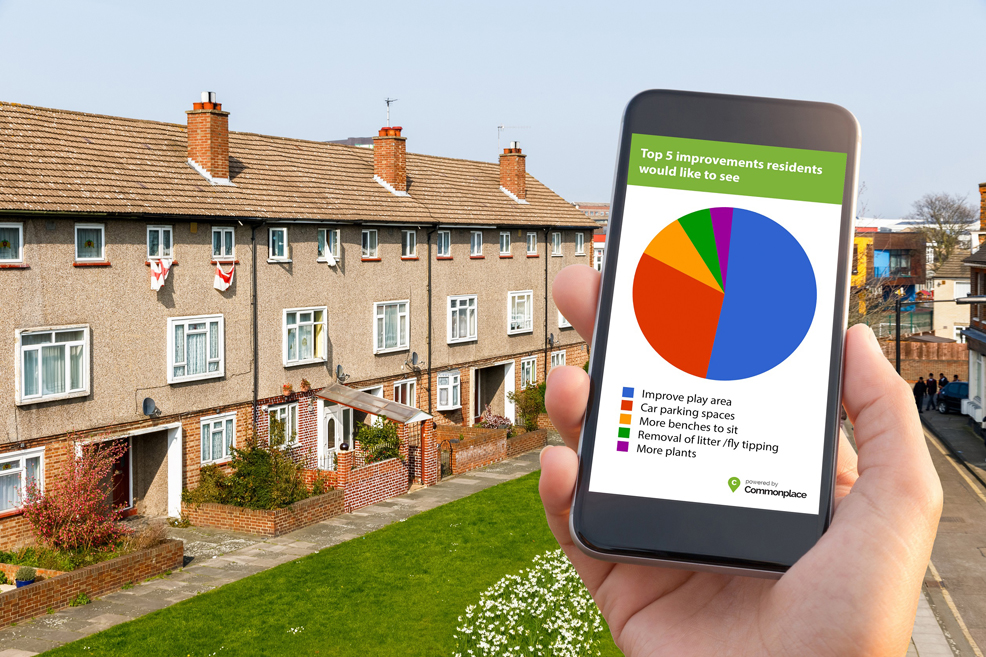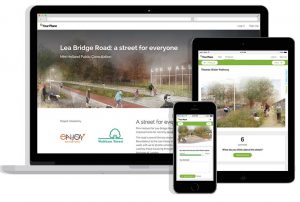
David Janner-Klausner, Co-Founder and Director of Business Development at Commonplace, shares the ways that digital tools can help achieve key goals of public engagement.
How far can you take engagement? Consulting and involving residents and stakeholder groups is often a statutory requirement and in any case perceived as a ‘good thing’ to do, but practicalities often get in the way. A budget must be used by a given date. Space needs to be allocated according to planning guidelines and changing these may be a lengthy process. Priorities identified by residents may incur additional costs. Suggested changes might disrupt planned and costed sequences for construction and regeneration.
These tensions around engagement are regular fixtures and need to be managed as part of the engagement process. Successful engagement involves managing the tensions by using tools that enable the best results in the time and budget available — digital tools can be used in this context to help make the most of engagement processes by reaching a large amount of people in diverse communities. It also means being very clear about the decision-making trajectory, it’s parameters and what may be influenced by engagement. It should also mean a commitment to transparency, even if things get awkward, and a technical proficiency to extract data from engagement and relay it back to the community.
In four words, what we are aiming for is: reach, transparency, trust and efficiency.
Engagement takes a variety of forms — leafleting, meetings, workshops, exhibitions and events — all designed to facilitate communication, deliver facts and receive feedback. Executed properly, each of these familiar methods can deliver reliable results, although achieving consistency of application and analysis across them can be difficult.
The fundamental change of the past decade has been the availability of digital tools that can help extend the reach of engagement and organise data. With these tools comes a democratisation of information — access to official documents is simpler, it is easier to organise and swap information, — residents and landlords can easily coordinate and publish their point-of-view. To avoid digital is to fall behind the curve – even if housing associations or local authorities are not embracing digital, you can be confident that some residents and tenants are.
Digital tools
Digital technologies cover a wide range of tools, which fall broadly into three categories, the first two being the most familiar — social media and survey tools such as SurveyMonkey. The third category is now emerging onto the market, comprising specialist platforms for public engagement in a civic context. Examples are Citizen Space as an all-round civic tool, tools for participatory budgeting, and tools specialising in the built environment, which is what Commonplace specialises in.
Each of the digital tools should be measured against the four fundamental engagement goals — reach, transparency, trust and efficiency. Reach requires a product to be easy to use and easy to disseminate, so that it can reach as much of the digitally-connected population as possible. Alongside reach, transparency is achieved where digital tools are transformative and information is widely accessible, without being dependent on physically finding it.

The best tools allow for a high degree of transparency — residents can not only get information about the project, but can also view other’s comments, trace the engagement process long-term and communicate with the project team via the engagement platform. As an example, Commonplace has supported engagement in the London Borough of Waltham Forest, some of which was concluded over two years ago. The engagement websites remain online so that when residents see change in their neighbourhood, they can track the provenance of the decision, regardless as to whether they agree or not.
Social media is a key component of digital engagement, yet one that has many intangibles. It’s risky — discussion can depart from facts rapidly, and feed on itself. We have seen in the past year that it is possible to channel large-scale trends on social media (in politics or advertising). But whatever the merits of such campaigns the resources needed for them are beyond the scope of most local authorities and social landlords. However, that is not a reason to disengage.
Social media
There are many other ways to use social media. One is to try and provide information by injecting a point-of-view into the social media streams. Another is to use social media conversations as mean of dissemination of the consultation — using it to broaden reach. At Commonplace we make a major effort to use social media to bring people onto our clients’ consultation sites, where they can look at information and engage in a more structured way, whilst their responses can be aggregated and analysed to create data.
These attributes underpin the key benefit of digital tools: efficiency. Whatever the chosen channel of communication — a one-on-one interview; a pop-up exhibition; distribution of paper forms; a public workshop — all of these should be underpinned by digital data gathering, and it is simply quicker, more consistent and more transparent to use a structured set of questions across all channels. A good digital platform will support the face-to-face as well as online engagement.
This data discipline is not just efficient — it is crucial for transparency and trust because it demonstrates (anonymously) which groups in the population have said what, and how different views can be weighted to help inform a decision. For example, data can be sliced and diced according to how people react to certain parts of a plan; responses typical to specific demographic groups; and so on.
All of this data and analysis of it, which has clear provenance, can feed into prioritisation and sequencing a development, meaning the expectations of different groups can be managed with transparency and integrity — so underpinning trust.








